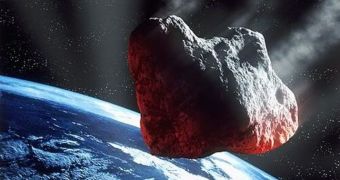Astronomers estimate that a near-Earth object (NEO) could pass close to our planet this week, but say that there is very little chance that an impact will take place following the event.
Tracking stations estimate that the object is less than 10 meters in diameter, although no clear data on its actual size are available at this point. Experts are continuously monitoring the space rock.
Designated 2010 TD54, the asteroid will pass between 52,000 kilometers (33,000 miles) to 64,000 kilometers (40,000 miles) away from the surface of the planet.
According to data on the International Astronomical Union's (IAU) Minor Planet Center website, the NEO will make its closest approach to Earth at 11:14 UT.
The new finding again highlights the need for better detectors in space, that could find NEO way before they get so close.
Though this one will most likely pass without causing any damage, small space rocks called airbursters are extremely dangerous for Earth, as demonstrated in 1908.
At that time, a small asteroid about 10 meters in diameter exploded 5 to 10 miles above northern Russia, devastating hundreds of square miles of Siberian forest, Universe Today reports.
Another instance when a NEO exploded above ground took place last year, in Indonesia. An airburster detonated with the strength of 50 kilotons of TNT, but fortunately not above a populated area.
The thing about these impactors is that they do not actually hit the ground. They are simply able to withstand the harsh conditions of atmospheric reentry, but eventually they explode in the air.
Astronomers say that the only way to detect these objects before they get so close to Earth is by employing sensitive infrared telescopes in our planet's orbit, that would keep an eye out for trouble.
The NASA Wide-field Infrared Survey Explorer (WISE) is one such telescope. The American space agency additionally uses the Spitzer Space Telescope for the same job.
But these two instruments are insufficient to keep track of the hundreds of thousands of space rocks that orbit the Sun in the inner solar system, in addition to the ones that come from the Kuiper Belt.
A series of low-cost missions have already been proposed, but lawmakers from countries hosting relevant space agencies do not seem too convinced that keeping an eye on NEO is a real necessity.

 14 DAY TRIAL //
14 DAY TRIAL //